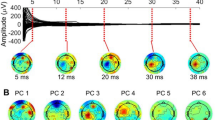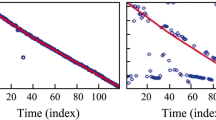Abstract
This paper deals with the blind adaptive identification of single-input multi-output (SIMO) finite impulse response acoustic channels from noise-corrupted observations. The normalized multichannel frequency-domain least-mean-squares (NMCFLMS) algorithm [1] is known to be a very effective and efficient technique for identification of such channels when noise effects can be ignored. It, however, misconverges in presence of noise [2]. In this paper, we present an analysis of noise effects on the NMCFLMS algorithm and propose a novel technique for ameliorating such misconvergence characteristics of the NMCFLMS algorithm for blind channel identification (BCI) with noise by attaching a spectral constraint in the adaptation rule. Experimental results demonstrate that the robustness of the NMCFLMS algorithm for BCI can be significantly improved using such a constraint.
Similar content being viewed by others
Abbreviations
- α:
-
arbitrary constant
- β:
-
Lagrangian multiplier
- γ:
-
smoothing parameter
- γ e :
-
positive real constant
- η:
-
positive real constant
- λ:
-
eigenvalue
- ρ:
-
step size
- τ:
-
separation between microphones
- J :
-
cost function
- R :
-
autocorrelation matrix
- M :
-
number of channels
- L :
-
length of channel impulse response
- s :
-
clean speech
- y :
-
reverberant speech
- x :
-
reverberant speech corrupted by noise
- v :
-
observation noise
- h :
-
channel impulse response
References
Huang Y. and Benesty J. (2003). A class of frequency-domain adaptive approaches to blind multichannel identification. IEEE Trans. Signal Processing, 51(1): 11–24
Hasan, M.K., Benesty, J., Naylor, P.A., Ward, D.B.: Improving robustness of blind adaptive multichannel identification algorithms using constraints. In: Proc. European Signal Processing Conference (2005)
Xu Z. and Tsatsanis M.K. (2000). Blind channel estimation for long code multiuser cdma systems. IEEE Trans. Signal Process 48(4): 1919–1930
Kaaresen K.F. and Taxt T. (1998). Multichannel blind deconvolution of seismic signals. Geophysics 63(6): 2093–2107
Subramaniam S., Petropulu A.P. and Wendt C. (1996). Cepstrum-based deconvolution for speech dereverberation. IEEE Trans. Acoust., Speech, Signal Process. 4(5): 392–396
Mourjopoulos J.N. (1994). Digital equalization of room acoustics. J. Audio Eng. Soc. 42(11): 884–900
Xu G., Liu H., Tong L. and Kailath T. (1995). A least-squares approach to blind channel identification. IEEE Trans. Signal Process. 43(12): 2982–2993
Gannot S. and Moonen M. (2003). Subspace methods for multimircophone speech dereverberation. EURASIP J Appl Signal Process. 11: 1074–1090
Hua Y. (1996). Fast maximum likelihood for blind identification of multiple FIR channels. IEEE Trans. Signal Process. 44(3): 661–672
Huang Y. and Benesty J. (2002). Adaptive multi-channel least mean square and newton algorithms for blind channel identification. Signal Process. 82(8): 1127–1138
Huang Y.A., Benesty J. and Chen J. (2005). Optimal step size of the adaptive multichannel lms algorithm for blind simo identification. IEEE Signal Process. Lett. 12(3): 173–176
Allen J.B. and Berkley D.A. (1979). Image method for efficiently simulating small-room acoustics. J. Acoust. Soc. Amer. 65(4): 943–950
Morgan D.R., Benesty J. and Sondhi M.M. (1998). On the evaluation of estimated impulse responses. IEEE Signal Process. Lett. 5(7): 174–176
Author information
Authors and Affiliations
Corresponding author
Rights and permissions
About this article
Cite this article
Haque, M.A., Bashar, M.S.A., Naylor, P.A. et al. Energy constrained frequency-domain normalized LMS algorithm for blind channel identification. SIViP 1, 203–213 (2007). https://doi.org/10.1007/s11760-007-0011-x
Received:
Revised:
Accepted:
Published:
Issue Date:
DOI: https://doi.org/10.1007/s11760-007-0011-x




